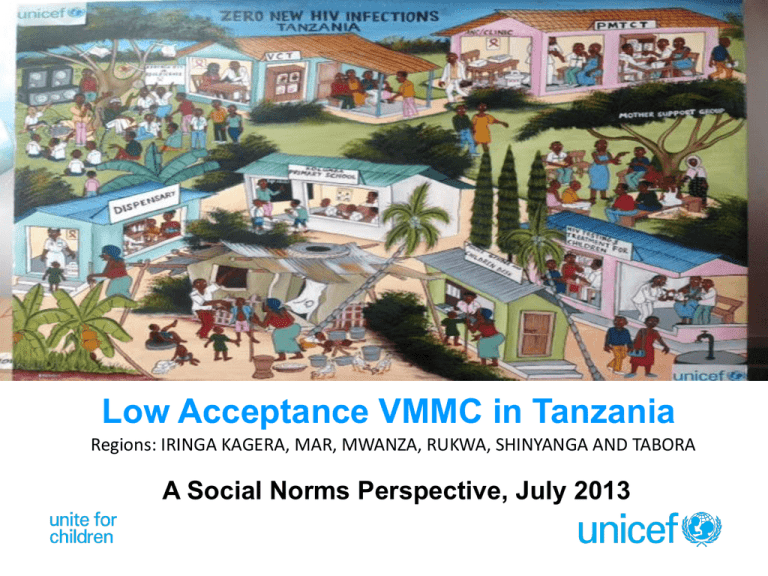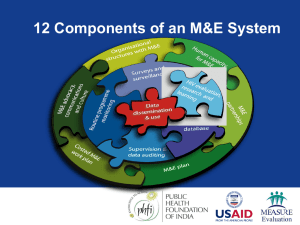Slide 1 - School of Arts & Sciences
advertisement

Low Acceptance VMMC in Tanzania Regions: IRINGA KAGERA, MAR, MWANZA, RUKWA, SHINYANGA AND TABORA A Social Norms Perspective, July 2013 Voluntary Male Circumcision in Tanzania Key Facts – THMIS 2011/12 Tanzanian Child Population is 22,416,000 (Under 18 years) – Total population is 44,841,000 (2010) World Bank; HIV National HIV Prevalence is 5.1% • Nearly three-quarters (72%) of Tanzanian men age 15-49 report having been circumcised. • Circumcision is more common in urban areas than in rural areas (94% versus 64%, respectively). • More than half of the regions on Mainland Tanzania show levels of male circumcision of 50% or more. • The prevalence of male circumcision is lowest in Rukwa (28%), Simiyu (30%), and Shinyanga (32%). In contrast, male circumcision in Zanzibar, Dar es Salaam, Mtwara, Tanga, Lindi, and Pwani regions is almost universal. • Circumcised men are less likely to be HIV infected than uncircumcised men (3.3% versus 5.2%). Among circumcised men, HIV prevalence is highest in the Southwest Highlands Zone (7.0%) and lowest in the Southern Zone (1.4%). • HIV prevalence for uncircumcised men increases with age until it peaks at age 35-39 (11.3%). • The social expectation is that adults man should be circumcised, which is contrary to the study findings of the THMIS 2012. • VMMC program is still relatively new in Tanzania, only 20% of recent MC clients were aged 20 and below. Full study report is available on http://www.nbs.go.tz/index.php?option=com_content&view=article&id=353:2011-12tanzania-hivaids-and-malaria-indicator-survey-thmis-report&catid=55:this&Itemid=145 Voluntary Male Circumcision in Tanzania Key Facts – THMIS 2011/12 What is New? Babu Magic Cup Babu Ambilikile Masapila (Right) distributing the Magic medicine into the Cups. Source: Regional Administrative Secretary and Arusha Regional Statistical Office, July 2011 Key Facts – THMIS 2011/12 Continue.., Levels of evidence for HIV prevention • • • • • Abstinence (100% less risky) Male circumcision (60% of less risk) Male condom Female condom Reducing # of sex partners (absolute and concurrent) • STD test for HIV • Abstinence promotion, with or without • Postponing sexual debut More evidence Raise risk perceptions around inter-generational, transactional and multiple partner behavior; Challenge attitudes around sexual and gender based violence; Promote use of HIV testing and counseling and condom use; Raise awareness among young people around PMTCT. Less evidence Government commitment to action President launching the elimination of Mother To Child Transmission of HIV Plan in 2010 New Adolescent HIV prevention radio program launched in 2013 Government commitment to action High level advocacy & commitment for HIV and AIDS: – Pres. launched eMTCT Plan & The HIV and Malaria Indicator Survey (THMIS III) • Opportunity to advance children & adolescent agenda for HIV & AIDS – Prime Minister launched National Costed Plan of Action 2011 • Opportunity for protecting children affected by HIV and AIDS – National Multi-sectorial Strategic Framework III - final draft available • Results focused and prioritizes women, children & Young People – Package of services for key population groups Innovation, implementation & scale up of high impact interventions – SHUGA radio program launched, model of public private partnership; engagement with Young People on HIV prevention • Demand creation, community mobilization & service delivery – HIV Testing and Counseling, condom use, Youth Friendly Services • Utilization of social media for monitoring & feedback; face book, twitter, Young Africa Live platform Social context/desirability of VMMC • The truth of acceptance by adult males within their communities is a process of “inter-dependent decision” and “reciprocal expectations” by the communities. • A survey in Tanzania where circumcision occurs shortly after birth, found that parents, especially fathers, of new-born boys cited social reasons as the main determinant for choosing circumcision (e.g. not wanting the son to ‘look different’ from the father). • Forces of modernity; schooling, modern health care, migration and intermingling with other people from other circumcising ethnic groups • Pressure from peers/lovers/family members and community • Religious order (Moslems/Christians) sign of purity • Culture –total way of life - Kurye in Mara region belief it’s a right of passage into adulthood from time memorial -Transition period -boy is prepared to take family responsibilities -Training in traditions and customs of their ethnic groups -period of assuming power, security, knowing the secrets of the tribe Whom to target.., to target Whom Universalistic (global) Prioritization/targeting/tailoring • • • • • Precision with or without diffusion Potential for greater yet limited impact on individuals Stigma, shame, fear, taboo Restricted benefits Restricted effects • • • Dilution Equality Equal access • Tipping point for social norms (reference group) Description of script for VMMC using the theoretical tools learned • MC is socially accepted and expected as part of rite to passage to adulthood, masculinity, and self-control and good behavior and purity with God (seventh day after birth). • Empirical expectation parents will circumcise their male boys through the traditional way • Normative expectation parents know that the community and their relevant networks expects good parents to circumcise their male boys appropriately to instill values • Inter-generational normative belief - I was raised up this way cutting is a religious requirement or identity and mostly could be done the traditional way using sharp instruments or blades • If this is a progressive law that protects children, inheritance and right to health then its legitimacy to observe will be strong and acceptability will be high but when the law is observed to be far from the norms it’s difficult to domesticate its enforcement (C. Bicchieri, 2013). Voluntary Medical Male Circumcision understanding the customs and beliefs • Deeply rooted social and personal beliefs, fears, stigma, shame and taboos around sex and sexual relations including the culture of silence –Not to express any fear or talk. • Initiators (ready for circumcision) of VMMC fear rejection and share within families, if they talk about their own experiences. • Circumcised male adults are seen as good men with strong – moral standard and respect – likely to be married easily. • Pluralistic ignorance – individual misperceive the attitude and behavior of others in a way that reduce willingness to intervene for this practice. What has been done so far From a social norms perspective • Advocacy /high-level political engagement -to move the study from paper to practice through a Multi-Sectoral approach – the buy-in is critical for community interventions and sustainability. • Public awareness messaging - primarily targeting general population, with broad messages without examining the relevant networks to determine the empirical and normative expectations from core beliefs. • Focused attention on disseminating /diffusion- through the eMTCT develop a communication strategy for engaging communities towards a new social norm – use male circumcision as a Primary prevention of HIV. Revisit our strategies – what we can do better and –change in practice Integration approach of both formal and informal institutions • Adopt a social norm approach with emphasis on engaging the relevant social networks to address empirical and normative expectations – community dialogue • Refocus the script/change language; less about bad traditional practices but more about right to health for family and community values – High level advocacy • Address possible dissonance between culture and core beliefs on MC and willingness for people within relevant network to intervene on VMMC – education campaigns • Promote adoption of new social norm on positive, intervening on VMMC through organized diffusion approaches – Media campaigns Strategies: • • Demand creation, community mobilisation and service delivery -MC Devices, VMMC Incentives, Operations research, Communication & resource mobilization etc. Meaningful involvement of young people through out the process of the developing the intervention on VMMC. – Youth involved in acting local community outreach events -radio show & theater art. – Young engaged as connectors to facilitate communication about the themes in the show using social media platforms (Facebook, Twitter) – Young people could play important potential role in focus group discussions in use of material in community (school clubs, community groups) • Strength, partnerships to expand exposure and support implementation: – Youth friendly radio stations/programme as broadcast partner. – Partnership required with government and health facilities to ensure availability of HIV testing and counseling services and preparedness to provide and monitor use of services by adolescents and young people. – Explore partnership with mobile phone service companies to support engagement with young people via SMS for monitoring and to promote use of and monitoring of use of HIV testing and counseling – Partnerships to prepare for translation into additional local languages. Address the informal -institutions Environmental – Changes in social and sexual norms Cognitive, attitudinal, affective e.g. fear of stigma Behavioral e.g. Condom use Biological; HIV, STI, Pregnancy etc Strengthen - Community modelapproach Create community dialogue core group Engage community through relevant network groups for value deliberations Adapting new social norm through public declaration and sanctions and rewards Deliberate on organized diffusion through community and social approaches Sustaining social norm harmonized with moral, social & legal system Measurement Monitoring and evaluation: – Use the existing routine monitoring systems with the guidance from MoH/NACP/partners – Explore Social Media platforms (YAL) for tracking social issues – Select set of indicators as needed to ensure basic data is collected on the intervention, coverage, knowledge, attitudes and associated changes in perceptions and behaviours. – Select the facilities for monitoring (service providers to be oriented on the radio and the monitoring tools to be adopted/or developed so as to be able to track the utilization of MC services including HIV Testing and Counseling (HTC) before, during and after. – Organize participatory approaches with community around MC and use simple qualitative tools etc. REFERENCE • • • • • • • • • C. Bicchieri, 2013. Social norms, social change – Lecture notes from UNICEF course on social norms, July 2013, University of Pennsylvania. T. Dooley, 2013. A Normal Poo! - Lecture notes from UNICEF course on social norms, July 2013, University of Pennsylvania. The National Strategy for Scaling Up Male Circumcision for HIV Prevention, United republic of Tanzania, Ministry of Health and Social Welfare, June 2010. The Tanzania HIV/AIDS and Malaria Indicator Survey 2011-12 (THMIS) H. Kohler, 2013. The Social and the Sexual: Networks in Contemporary Demographic Research - Lecture notes from UNICEF course on social norms, July 2013, University of Pennsylvania. G. Mackie, 2013.Social Dynamics of Norm Shift - Lecture notes from UNICEF course on social norms, July 2013, University of Pennsylvania. G. Mackie, 2013. Outlaw Harmful Social Norms? - Lecture notes from UNICEF course on social norms, July 2013, University of Pennsylvania. R. Muldoon, 2013. Social Network Analysis. Lecture notes from UNICEF course on social norms, July 2013, University of Pennsylvania. WHO. New Data on Male Circumcision and HIV/AIDS prevention: Policy and Programme Implications. WHO. Geneva. 2007/2010 Recommendations Thank you- Asanteni Tanzania House of Talent – used for HIV prevention campaigns



